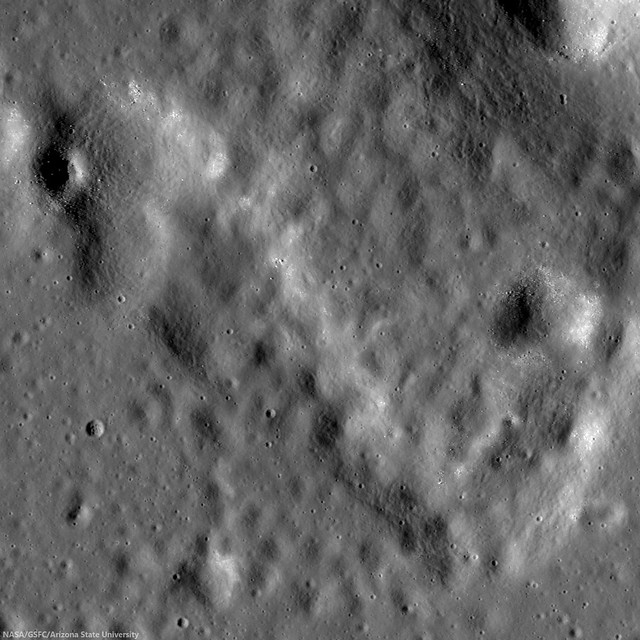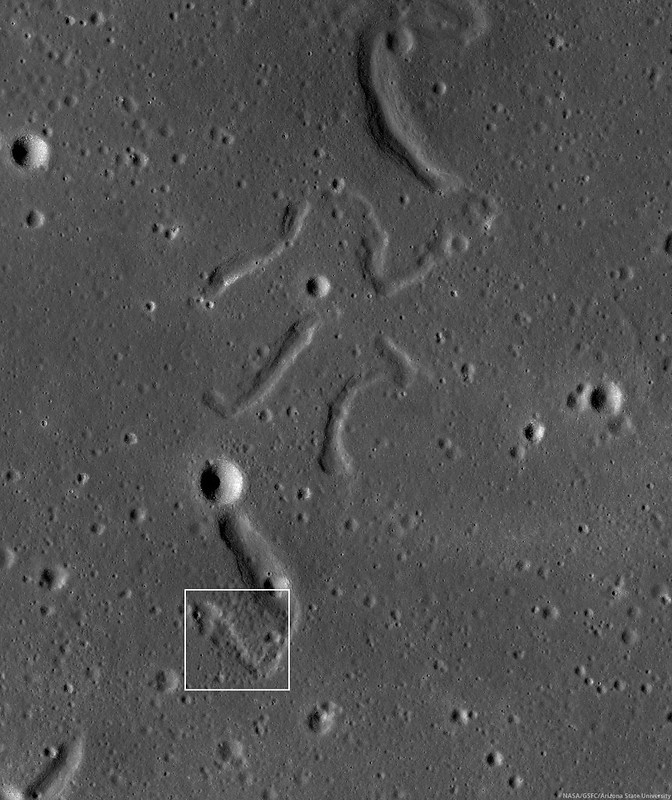 |
| Uneven depression near the north end of Rima Suess, west of Kepler in Oceanus Procellarum. Image centered on 9.109°N, 311.396°E; field of view 1.38 km; LROC Narrow Angle Camera (NAC) observation NAC M1112132406L, spacecraft orbit 16148, January 6, 2013; illumination from the west an an incidence angle of 67° at 1.14 meters per pixel resolution from 113.56 km [NASA/GSFC/Arizona State University]. |
Hiroyuki Sato
LROC News System
Rima Suess is one of many sinuous rilles on the Moon. Located in Oceanus Procellarum between the Marius Hills and Kepler crater, it is about 165 km long and trends in a NNW-SSE direction. Sinuous rilles often exhibit meandering channels, which may have formed as open channels or lava tubes which subsequently collapsed.
About 1 km north from the northern end of Rima Suess, there are 5-7 enclosed, irregularly aligned sinuous depressions (see next NAC context image). These are likely all related to another Sinuous rille (about 30 km long) at the north of these depressions (see WAC context image). The opening image highlights the southern, less well-developed tail of one of these irregularly-aligned sinuous depressions. The subsidence here seems to have proceeded unevenly and then stopped, although it is possible that the subsidence is still ongoing, albeit very slowly.
The enclosed, isolated depressions indicate the potential collapse of a subsurface void, which in this case is likely to have been lava tubes. One potential hypothesis is that the thickness of the lava tube roof in this region of the Moon is variable, so in some places the roof is thinner (meaning less strong) than in other places. The thinner roofs would be more prone to collapse, resulting in a partially collapsed tube and the discontinuous channels in the Rima Suess area that you see today.
One of the lunar pits, which are possible entrances to the subsurface voids, are located in the middle of a sinuous rille near the Marius Hills. Even though no pits had been observed in this northern Rima Suess area, the subsurface caves could be still there, waiting for us to explore.
Enjoy the full resolution NAC mosaic of Rima Suess, HERE.
Related LROC Posts:
Depths of Mare Ingenii
How Common are Mare Pit Craters?
New Views of Lunar Pits
Sublunarean void!
Impact Melt Pit
Diversity of Basaltic Lunar Volcanism
Sinuous Chain of Depressions
Secrets of Schröteri
Marius Hills Pit - Lava Tube Skylight?
LROC News System
Rima Suess is one of many sinuous rilles on the Moon. Located in Oceanus Procellarum between the Marius Hills and Kepler crater, it is about 165 km long and trends in a NNW-SSE direction. Sinuous rilles often exhibit meandering channels, which may have formed as open channels or lava tubes which subsequently collapsed.
About 1 km north from the northern end of Rima Suess, there are 5-7 enclosed, irregularly aligned sinuous depressions (see next NAC context image). These are likely all related to another Sinuous rille (about 30 km long) at the north of these depressions (see WAC context image). The opening image highlights the southern, less well-developed tail of one of these irregularly-aligned sinuous depressions. The subsidence here seems to have proceeded unevenly and then stopped, although it is possible that the subsidence is still ongoing, albeit very slowly.
 |
| Northern portion of Rima Suess from LROC NAC mosaic M1112132406LR, centered near 9.22°N, 311.45°E, field of view about 9.2 km across. White box outlines field of view in LROC Featured Image released January 31, 2014 [NASA/GSFC/Arizona State University]. |
 |
| LROC Wide Angle Camera (WAC) context view of Rima Suess, centered on 9.38°N, 311.38°E. LROC NAC M1112132406LR footprint outlined in blue, with the location of the area shown at high resolution in the Featured Image marked with a yellow arrow [NASA/GSFC/Arizona State University]. |
Enjoy the full resolution NAC mosaic of Rima Suess, HERE.
Related LROC Posts:
Depths of Mare Ingenii
How Common are Mare Pit Craters?
New Views of Lunar Pits
Sublunarean void!
Impact Melt Pit
Diversity of Basaltic Lunar Volcanism
Sinuous Chain of Depressions
Secrets of Schröteri
Marius Hills Pit - Lava Tube Skylight?


No comments:
Post a Comment